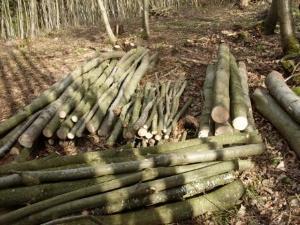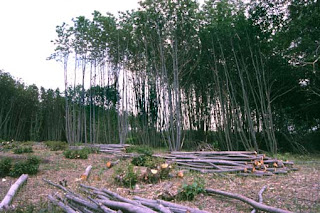Before I moved here to the Limousin, I had never really seen a Sweet Chestnut tree, in the far northern part of the Yorkshire Dales which used to be my home you just didn't see them. I new of only one tree on a nearby country estate which had only ever fruited once in the glorious summer of 1976. So seeing them here in their glorious profusion, reliably fruiting every year, for me really highlights the climatic benefits of living here in S.W. France compared to 700 miles further North.
In my locality it is like a weed, springing up everywhere, you cut it down and back it comes - twice as fast as before you cut it and that of course is one of the great qualities of this tree.
Looking at it's success today you would think that it's always been here - a native tree to this part of Western Europe but it's not. This came as something of a surprise to me and I thought that I new about trees! Infact it comes from Turkey and was planted thoughout Europe by the Romans who enjoyed the chestnuts and appreciated the versitility of this tree.
For myself, this ability that Sweet Chestnut has to reliablily keep regrowing each time it is cut down is sheer brilliance. Although it is widely known that many other tree species can be coppiced, few do so here with quite the same vigour and youthful enthusiasm of the sweet chestnut. I have honestly had regrowth exceeding 3 meters in the first summer after cutting, in a woodland situation this same regrowth is already starting to close up it's developing canopy after only 3 years. Compare this to a newly planted woodland, which could take perhaps 8-12 years to reach the same stage- depending on species and planting distance.
The length of each coppice cycle varies depending on what is the desired end product. Very generally speaking an established coppice is cut over on cycles of between 10 and 20 years, this will yield large amounts of wood for fence posts, poles for a varied range of uses, some firewood and a large quantity of brushwood which in the past would have been used for pea and bean sticks. | A recently cut Sweet Chestnut stool showing vigourous and prolific regrowth of up to 2 meters in length at the end of it's first season of regrowth |
 |
| A selection of varying sized material that a short rotation Sweet Chestnut coppice can yield. |
As commercial pressures increase, many land owners are trying to squeeze every penny from their woods. The potential now exists to make this kind of "waste" brash into wood pellets for domestic or industrial heating. Follow the link to this site www.pellet-mill.de for home production pellet mills priced from only 2200 euros and are claimed to be capable of a production of 100-250 kilos/hour. According to the manufacturers you can also use materials like leaves,grass, paper and cardboard-including the junk mail-now that has to be the best use for it yet!
For me personally, I prefer a longer rotation of 35-45 years as I am wanting good quality logs to mill into planks with the remainder for firewood. Growing a coppice on a cycle of this time span means that thinning must be done periodically to reduce the density of tree stems. Thinning involves removing the stems that are badley shaped and/or overcrowded, this is to ensure that the growth is concentrated in the better quality trunks. Failure to do this will lead excessively long whippy trees with small crowns, the overall growth and wood yield of the coppice plantation will stagnate and a low value crop will result.
Here in the Limousin, Sweet Chestnut grows very well, you should start thinning this type of long rotation coppice at around 15 years old followed by a regular thinning every 3-5 years. The first thinning is the most labourious and time consuming as you are removing 35% to 50% of the tree stems, this can seem a little dramatic when you cut it- in some dense patches you get so many logs on the woodland floor there is barely anywhere to put your feet! However after the first summer the canopy is closing up again and you are left wondering if you should have thinned it just a little bit harder!
The second and subsequent thinings are much quicker, easier and more productive as the stems are of a larger girth and you have already removed the poor quality ones. At this stage although your woodland is still technically a coppice, but to all intents and purposes like a well managed woodland.
| A year ago this looked just like the previous photo. Now with all of the overcrowded and worst shaped trunks removed it looks a lot more promising |
Thinning the coppice also has other benefits, the increase in light intensity reaching the woodland floor allows a herb layer to develop which makes it more interesting to insects and birds. The chestnut trees are also becoming mature enough to yield nuts which on these relatively young trees are less prolific but of a good size. Do not however delay picking them for long as the wildlife hoovers them up and stashes them away in no time, then the leaves fall and hide any leftovers.
Thinning the coppice also has other benefits, the increase in light intensity reaching the woodland floor allows a herb layer to develop which makes it more interesting to insects and birds. The chestnut trees are also becoming mature enough to yield nuts which on these relatively young trees are less prolific but of a good size. Do not however delay picking them for long as the wildlife hoovers them up and stashes them away in no time, then the leaves fall and hide any leftovers.
As each year pases, the final felling of the coppice approaches, this final act completes the growth cycle, to delay is not wise as decay will start to invade the base of many trunks. Sweet Chestnuts also have a tendancy to twist with age, you can see the spiral patten in the bark, splitting logs like this results in near corkscrew shaped splits that are a pain to stack and cut. Also the stools become top heavy and more likely to blow over in severe storms, as many of mine did here in the hurricane force winds of December 1999.
Once they are felled you have not only a sizable amount of wood but the joy of watching the spectacular regrowth that flourishes from each cut stool and the accompanying surge in growth of the ground flora. This coppice cycle can repeat almost endlessly with the coppice stools slowly getting larger and more powerful over the course of many hundreds of years.
One final thing to note that I have noticed, is when really huge Chestnut stools are felled they appear to have a greatly reduced ability to regenerate. These monsters usually have 3 or 4, sometimes 5 or more large trunks, each one perhaps between 30cm and 60cm in diameter, I have found that if you cut all these off in the same year often the stool will only produce a very few shoots or none at all. These isolated shoots are very vulnerable to deer damage and to being split off by gusts of wind, if this happens a huge coppice stool that may have had a lifespan of over four hundred years is lost and belive me it's a sad realisation when you realise that you have needlessly caused this because you were ignorant of the correct cutting techniques for these special ancient trees.
By a process of trial and error I have found that if you cut down around half of the trunks one year, the stools regenerate really well,it is better to cut all the adjacent stems on one half of the stool. New vigorous regrowth will emerge from around the base of the cut trunks, you then let this grow for 2 or 3 years by which time it will probably be 2 to 3 meters in height. Only once this new growth is well established can you finally take down the remaining large trunks on the other side of the stool.
| Here is an example of an ancient overmature Sweet Chestnut coppice stool, Last winter I have removed the trunks positioned on the front side-which is the side that is exposed to most light. New shoots have emerged from below where the trunks were felled. As you can see the regrowth is not as prolific or vigorous as the photo at the begining of this blogpost. I will leave it at least another year to fell the remaining trunks. You can see a patch of decay on the trunk on the left, a strong indication that parts of this stool are close to collapse. |
By keeping some of the original trunks it keeps the sap being pulled up through the stool and maintains the ability of the new growth to resprout on the cut side. I suspect that as the stool ages it is less able to respond succesfully to the sudden shock that a felling of all the trunks must inflict upon it. So these really old trees need a more thoughtful approach to regenerate them, the problem is that if they are not cut, they blow over really easily, often lifting the entire root system out of the ground. Once this happens they are lost forever because the agricultural system that created them has long since dissappeared.
By keeping some of the original trunks it keeps the sap being pulled up through the stool and maintains the ability of the new growth to resprout on the cut side. I suspect that as the stool ages it is less able to respond succesfully to the sudden shock that a felling of all the trunks must inflict upon it. So these really old trees need a more thoughtful approach to regenerate them, the problem is that if they are not cut, they blow over really easily, often lifting the entire root system out of the ground. Once this happens they are lost forever because the agricultural system that created them has long since dissappeared.
